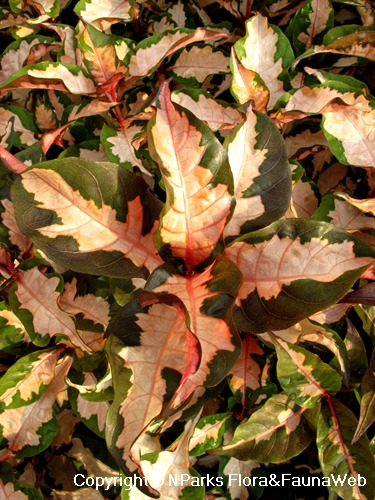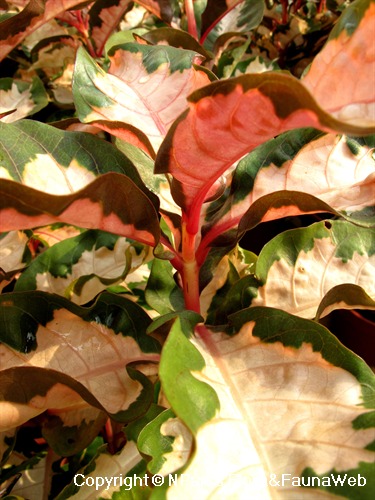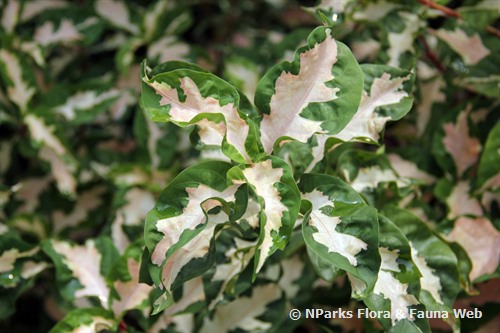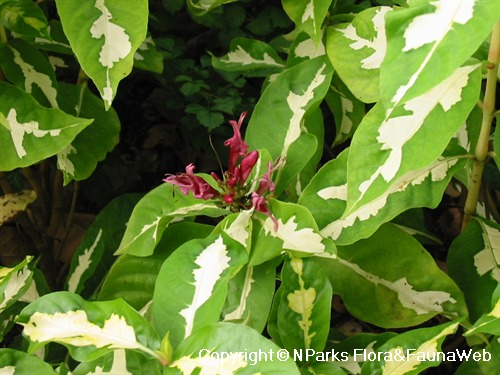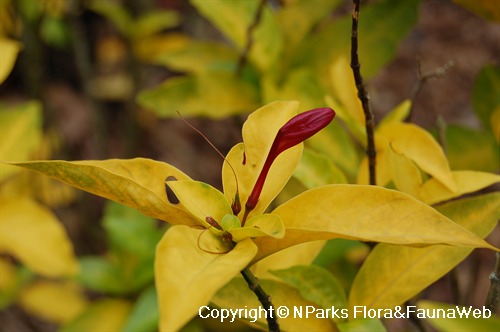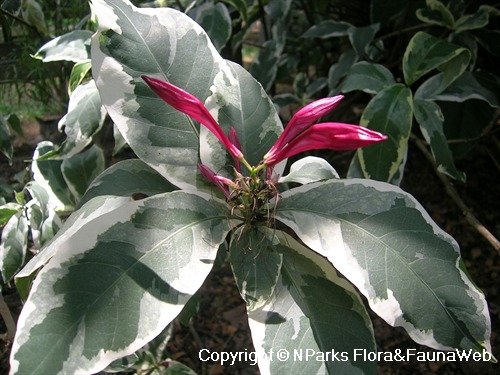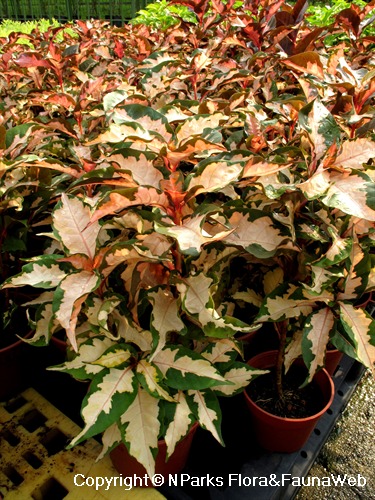
Back
Graptophyllum pictum 'Tricolor'
| Family Name: | Acanthaceae |
| Common Name: | Tricolor Caricature Plant, Waimea Caricature Plant |
Name
Classifications and Characteristics
| Plant Division | Angiosperms (Flowering Seed Plants) (Dicotyledon) |
|---|---|
| Plant Growth Form | Herbaceous Plant |
| Lifespan (in Singapore) | Perennial |
| Mode of Nutrition | Autotrophic |
| Maximum Height | 1 m to 2 m |
Biogeography
| Preferred Climate Zone | Tropical |
|---|
Description and Ethnobotany
| Others - Plant Morphology | Growth Form: Herbaceous shrub with erect growth habit. Stem: Young herbaceous stem is red. Foliage: Opposite leaves are elliptic with entire or wavy leaf margin (15 cm long). Leaves are mostly green with mixed patches of peach, cream and pink along the midvein. Hairless, glossy leaves have an uneven leaf texture. Flowers: Reddish purple or pinkish purple flowers are tubular and located near the stem tips in clusters (4 cm long, 1 cm wide). Landscaping: This cultivar is grown for its ornamental, colourful foliage which create a tropical look. It is suitable for planting in large containers and would grow well on a sunny patio. The uneven, wrinkled leaves will provide texture to landscapes when placed in mass plantings. It can be pruned into a hedge or screen. Cultivation: This fast-growing species is easy to grow and ideal for hot, humid climates. Leaves will be most colourful when plants are grown under full sun, but plants can tolerate partial shade. Specimens should ideally be planted 1.2 - 1.8 m apart in fertile, well-drained soil that is kept moist. However, this cultivar is tolerant of waterlogged soils and would be suitable for poorly drained areas. Apply a complete, balanced fertilizer once a month for outdoor plants and twice a month for potted plants. This cultivar should be pruned to maintain a compact shape. It is usually resistant to most pests and diseases, but may be attacked by mealy bugs and aphids. Propagation: Propagate by stem cuttings which root easily. Etymology: The genus "Graptophyllum" is derived from the Greek word for inscribed ("graptos") and the Latin word for leaf ("phyllon"). The reference is to the leaves typical of species in this genus which look like they were painted. The species epithet "pictum" originates from the Latin word "pictus" which means colored and refers to the colourful leaves of this species. |
|---|
Landscaping Features
| Desirable Plant Features | Ornamental Foliage, Ornamental Stems |
|---|---|
| Landscape Uses | General, Riverine, Hedge / Screening, Container Planting |
Plant Care and Propagation
| Light Preference | Full Sun |
|---|---|
| Water Preference | Lots of Water |
| Plant Growth Rate | Fast |
| Rootzone Tolerance | Easy to Grow, Fertile Loamy Soils, Well-Drained Soils, Waterlogged Soils (Drains Site), Disease / Pest Resistant |
| Maintenance Requirements | Low |
| Propagation Method | Stem Cutting |
| Planting Distance | 1 to 1 |
Foliar
| Mature Foliage Colour(s) | Cream / Off-White, Green, Orange, Pink |
|---|---|
| Mature Foliage Texture(s) | Glossy / Shiny |
| Foliar Type | Simple / Unifoliate |
| Foliar Arrangement Along Stem | Opposite |
| Foliar Shape(s) | Non-Palm Foliage (Elliptical) |
| Foliar Venation | Pinnate / Net |
| Foliar Margin | Entire, Entire - Wavy / Undulate |
| Foliar Apex - Tip | Acute |
| Foliar Base | Acute |
| Typical Foliar Area | Mesophyll ( 45cm2 - 182.25 cm2 ) |
Non - Foliar and Storage
| Stem Type & Modification | Herbaceous |
|---|---|
| Root Type | Underground (Tap Root) |
Floral (Angiosperm)
| Flower Colour(s) | Pink, Purple, Red |
|---|---|
| Flower Symmetry | Radial |
| Individual Flower Shape | Tubular |
| Flower Size - Remarks | 4 cm long, 1 cm wide |
| Flowering Habit | Polycarpic |
Image Repository
Others
| Master ID | 29922 |
|---|---|
| Species ID | 4231 |
| Flora Disclaimer | The information in this website has been compiled from reliable sources, such as reference works on medicinal plants. It is not a substitute for medical advice or treatment and NParks does not purport to provide any medical advice. Readers should always consult his/her physician before using or consuming a plant for medicinal purposes. |

